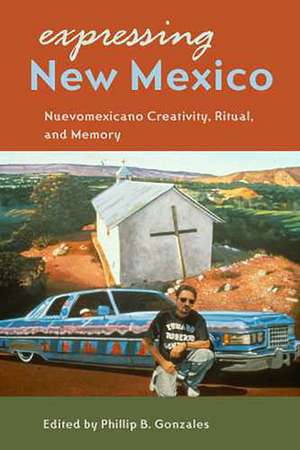Expressing New Mexico: Nuevomexicano Creativity, Ritual, and Memory
Editat de Phillip B. Gonzalesen Limba Engleză Paperback – 25 oct 2007
The culture of the Nuevomexicanos, forged by Spanish-speaking residents of New Mexico over the course of many centuries, is known for its richness and diversity. Expressing New Mexico contributes to a present-day renaissance of research on Nuevomexicano culture by assembling eleven original and noteworthy essays. They are grouped under two broad headings: “expressing culture” and “expressing place.” Expressing culture derives from the notion of “expressive culture,” referring to “fine art” productions, such as music, painting, sculpture, drawing, dance, drama, and film, but it is expanded here to include folklore, religious ritual, community commemoration, ethnopolitical identity, and the pragmatics of ritualized response to the difficult problems of everyday life.
Intertwined with the concept of expressive culture is that of “place” in relation to New Mexico itself. Place is addressed directly by four of the authors in this anthology and is present in some way and in varying degrees among the rest. Place figures prominently in Nuevomexicano “character,” contributors argue. They assert that Nuevomexicanos and Nuevomexicanas construct and develop a sense of self that is shaped by the geography and culture of the state as well as by their heritage.
Many of the articles deal with recent events or with recent reverberations of important historical events, which imbues the collection with a sense of immediacy. Rituals, traditions, community commemorations, self-concepts, and historical revisionism all play key roles. Contributors include both prominent and emerging scholars united by their interest in, and fascination with, the distinctiveness of Nuevomexicano culture.
Intertwined with the concept of expressive culture is that of “place” in relation to New Mexico itself. Place is addressed directly by four of the authors in this anthology and is present in some way and in varying degrees among the rest. Place figures prominently in Nuevomexicano “character,” contributors argue. They assert that Nuevomexicanos and Nuevomexicanas construct and develop a sense of self that is shaped by the geography and culture of the state as well as by their heritage.
Many of the articles deal with recent events or with recent reverberations of important historical events, which imbues the collection with a sense of immediacy. Rituals, traditions, community commemorations, self-concepts, and historical revisionism all play key roles. Contributors include both prominent and emerging scholars united by their interest in, and fascination with, the distinctiveness of Nuevomexicano culture.
Preț: 204.65 lei
Preț vechi: 289.70 lei
-29% Nou
Puncte Express: 307
Preț estimativ în valută:
39.16€ • 40.89$ • 32.34£
39.16€ • 40.89$ • 32.34£
Carte indisponibilă temporar
Doresc să fiu notificat când acest titlu va fi disponibil:
Se trimite...
Preluare comenzi: 021 569.72.76
Specificații
ISBN-13: 9780816526284
ISBN-10: 0816526281
Pagini: 336
Dimensiuni: 152 x 229 x 23 mm
Greutate: 0.48 kg
Ediția:1
Editura: University of Arizona Press
Colecția University of Arizona Press
ISBN-10: 0816526281
Pagini: 336
Dimensiuni: 152 x 229 x 23 mm
Greutate: 0.48 kg
Ediția:1
Editura: University of Arizona Press
Colecția University of Arizona Press
Notă biografică
Phillip B. Gonzales is Professor of Sociology and chair of the department at the University of New Mexico. He is the author of Forced Sacrifice as Ethnic Protest: The Hispano Cause in New Mexico and the Racial Attitude Confrontation of 1933.
Recenzii
“This text is a splendid and artful construction of New Mexico’s ‘culture’ by post-Chicano intellectuals who are critical and analytical.” — Western Historical Quarterly
“The strength of the assembled essays makes this text an enriching read for those wishing to discover more about the scope and nature of the flavor of Nuevomexicano culture.” —New Mexico Historical Review
“The strength of the assembled essays makes this text an enriching read for those wishing to discover more about the scope and nature of the flavor of Nuevomexicano culture.” —New Mexico Historical Review
